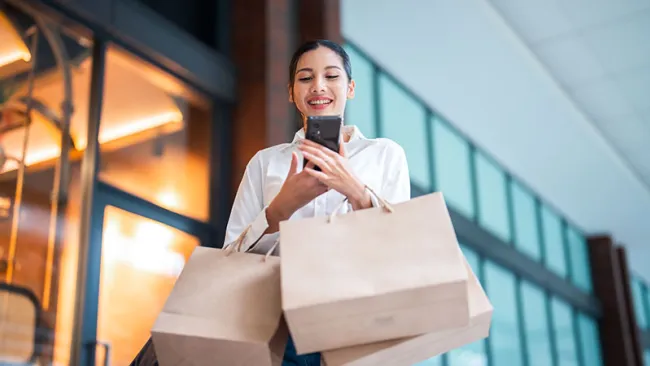The holiday shopping season is in full swing, despite supply chain disruptions, inflation, and the new COVID-19 omicron variant. So, how is it going? Results from Black Friday and Cyber Monday point to changes in customer behavior and customer experience that are reshaping the retail holiday season for years to come. Customer experience experts also provided tips on what retailers can do to overcome those challenges and make the most of the holidays and beyond.
Holiday shopping started even earlier
Retailers rolled out their holiday marketing just as Halloween wrapped up—some even earlier than that—as many consumers got a head start on their holiday shopping. Holiday creep existed even before the pandemic. But this year, news about supply chain issues and inventory shortages added new urgency to an early start.
Retailers launched deals and other offers in October and early November, with nearly half (49%) of shoppers saying they took advantage of early holiday sales or promotions before Thanksgiving this year, reported the National Retail Federation. “Over the last few years consumers have shifted their holiday shopping plans to start earlier in the season,” said NRF President and CEO Matthew Shay in a statement.
Thanksgiving and Cyber Monday shopping declined for the second year in a row
The number of online and in-store shoppers declined for the second year in a row between Thanksgiving Day and Cyber Monday, down from 186.4 million last year to 179.8 million, according to the National Retail Federation. The decline can be attributed to a number of factors, including consumers shopping earlier, and emphasizes the reality that Thanksgiving no longer kicks off the holiday shopping season. Rather, it is more like other milestones such as Small Business Saturday, Cyber Monday, and Giving Tuesday.
Shoppers (somewhat) returned to stores
Compared to this time last year, more consumers are doing their shopping in stores. A study by digital marketing agency Adtaxi found that nearly two-thirds (64%) of respondents felt comfortable shopping in-store this holiday season, up from 50% in last year’s survey.
But while store traffic increased, it hasn’t reached pre-pandemic levels. Store traffic rose 61% on Black Friday but was down 27% from 2019, according to RetailNext. Placer, another firm that measures store traffic found similar results: visits to indoor malls increased by 83% from last year but fell by about 9% compared to 2019.
SMBs are using multiple online marketplaces to reach customers
Small businesses are deploying various methods of selling their products, especially online. A study from Data Catalyst Institute showed that 87% of SMB sellers on Amazon’s online marketplaces also sell on at least one other online marketplace, including 54% also selling on Walmart’s marketplace and 50% also selling on eBay.
The study also showed that the average SMB seller uses five different methods of selling their products, with brick and mortar (79%) and wholesale (78%) remaining the most popular, and online marketplaces (68%) and business-owned websites (68%) right behind them.
Curbside pickup persists
Consumers continue to use curbside pickup, reflecting ongoing pandemic concerns as well as a desire for convenience, according to Adobe. In November, curbside pickup was up 70% compared to two years ago. Although as online shopping and deliveries picked up, curbside pickup was used in 18% of all online orders on Cyber Monday (for retailers that offered the service), down from 20% last year. These figures suggest, however, that curbside pickup is here to stay.
Retailers could still see a strong holiday season
Retailers and consumers continue to grapple with a host of pandemic and supply chain-related disruptions but despite those challenges, NRF Chief Economist Jack Kleinhenz is optimistic that the season could “turn out even better than we expected.”
“Consumers and retailers have both revised their playbooks and broken with previous traditions,” Kleinhenz said in a statement. “With the momentum we’ve seen so far likely to continue, it seems probable that we will exceed our initial projection [that holidays sales between November and December will be up 8.5 and 10.5% from 2020].”
Similarly, Adobe estimates that the full holiday shopping season (November through December) will hit $207 billion, a 10% increase from last year.
Key takeaways
Changes in customer behavior and shopping preferences during the holiday season point to a continuing trend: Consumers expect to shop whenever and wherever they want to, whether it’s in-person or digital. And for better or worse, retail is not returning to pre-pandemic days. It’s up to retailers to find creative and cost-effective ways to meet these expectations, noted Sandra Duff, president of consulting firm Jackman.
“At the end of the day, we've opened Pandora's box with consumers, bars have been raised, and brands need to deliver a higher touch experience,” she said. “But more importantly, retailers need to know what their core customers are looking for to stand out.”
Indeed, at a time when retailers have to fight for every customer, it’s imperative that they reinforce that “irrational loyalty,” said Deb Gabor, CEO of Sol Marketing, a brand strategy consultancy. “Irrational loyalty is a bond that you develop with customers where they choose your brand every time,” Gabor said.
There are a number of things that retailers can do even in the midst of a busy holiday season to build irrational loyalty, Gabor continued, such as:
- Remember that your associates are your brand. Show your associates that you value them and double down training that helps associates deliver value to the customer in turn.
- Go beyond transactional relationships. Instead of emphasizing sales, look for other ways to stand out: offer special store hours for valued customers, add additional services such as free gift-wrapping and other perks.
- Be cognizant of the customer experience from beginning to end. Let customers know beforehand how long a delivery will take, provide status updates, and make it easy for customers to get in touch.
And finally, “tap into the humanity of the relationship,” Gabor said. “As more retailers make customer and employee experience the standard, retail will be better during and after the holidays.”
















